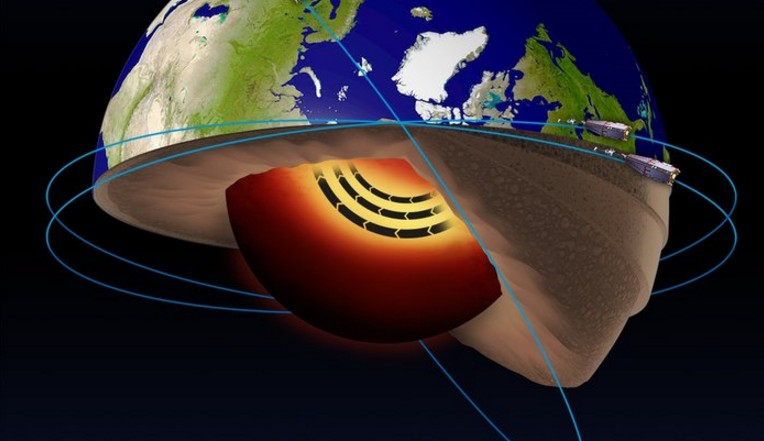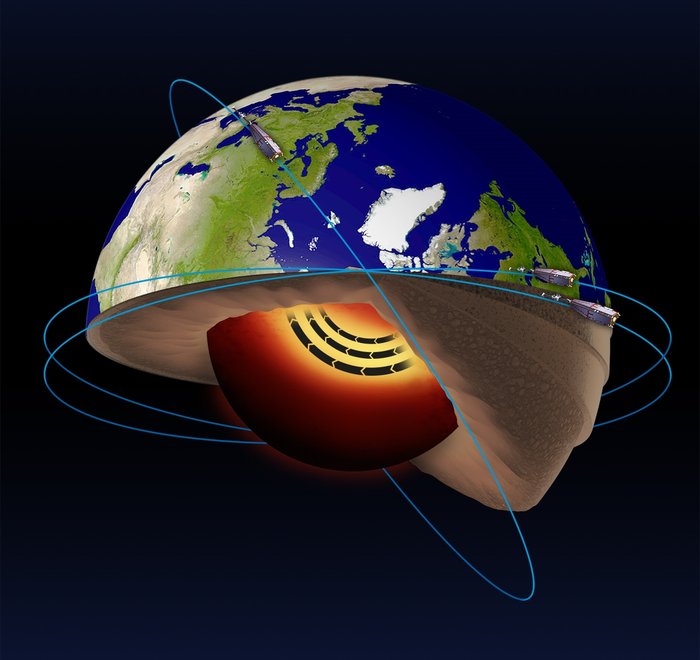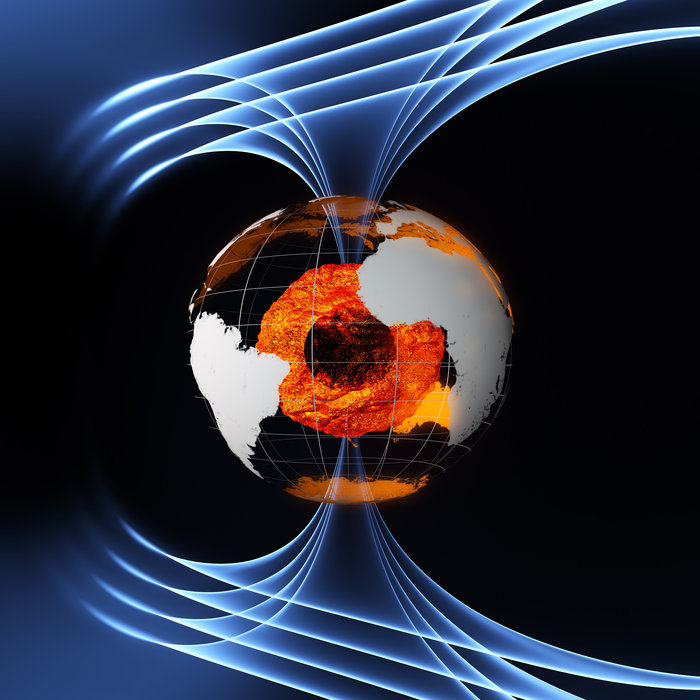Accelerating high-latitude jet stream discovered in Earth’s core

Scientists using data obtained by ESA's Swarm constellation of satellites have discovered a jet stream in the liquid iron part of Earth’s core 3 000 km (1 864 miles) beneath the surface. In addition, Swarm satellite data show that this jet stream is speeding up.
Launched in 2013, the trio of Swarm satellites are measuring and untangling the different magnetic fields that stem from Earth’s core, mantle, crust, oceans, ionosphere and magnetosphere. Together, these signals form the magnetic field that protects us from cosmic radiation and charged particles that stream towards Earth in solar winds.
Measuring the magnetic field is one of the few ways we can look deep inside our planet. The field exists because of an ocean of superheated, swirling liquid iron that makes up the outer core. Like a spinning conductor in a bicycle dynamo, this moving iron creates electrical currents, which in turn generate our continuously changing magnetic field. Tracking changes in the magnetic field can, therefore, tell researchers how the iron in the core moves.
The accurate measurements by the unique constellation of Swarm satellites allow the different sources of magnetism to be separated, making the contribution from the core much clearer.
"Thanks to the mission we have gained new insights into the dynamics of Earth’s core and it’s the first time this jet stream has been seen, and not only that – we also understand why it’s there," said lead author Phil Livermore from the University of Leeds in the UK
One feature is a pattern of ‘flux patches’ in the northern hemisphere, mostly under Alaska and Siberia.
"These high-latitude flux patches are like bright spots in the magnetic field and they make it easy to see changes in the field," explained Dr. Livermore.
Swarm reveals that these changes are actually a jet stream moving at more than 40 km (25 miles) a year – three times faster than typical outer-core speeds and hundreds of thousands of times faster than Earth’s tectonic plates move.
"We can explain it as acceleration in a band of core fluid circling the pole, like the jet stream in the atmosphere," Livermore said.

ESA’s Swarm satellites have led the discovery of a jet stream in the liquid iron part of Earth’s core 3000 km beneath the surface. In addition, Swarm satellite data show that this jet stream is speeding up. Launched in 2013, the Swarm trio is dedicated to identifying and measuring precisely the different magnetic signals that make up Earth’s magnetic field. Credit: ESA
So, what is causing the jet stream and why is it speeding up so quickly?
The jet flows along a boundary between two different regions in the core. When material in the liquid core moves towards this boundary from both sides, the converging liquid is squeezed out sideways, forming the jet.
"Of course, you need a force to move the fluid towards the boundary," says Prof. Rainer Hollerbach, also from the University of Leeds.
"This could be provided by buoyancy, or perhaps more likely from changes in the magnetic field within the core."
As for what happens next, the Swarm team is watching and waiting.

Earth’s magnetic field is thought to be generated largely by an ocean of superheated, swirling liquid iron that makes up Earth’s outer core 3 000 km (1 864 miles) under our feet. Acting like the spinning conductor in a bicycle dynamo, it generates electric currents and thus the continuously changing electromagnetic field. Credit: ESA/AOES Medialab
"Further surprises are likely. The magnetic field is forever changing, and this could even make the jet stream switch direction," said Rune Floberghagen, ESA’s Swarm mission manager.
This feature is one of the first deep-Earth discoveries made possible by Swarm. With the unprecedented resolution now possible, it’s a very exciting time – we simply don’t know what we’ll discover next about our planet."
Abstract:
Observations of the change in Earth’s magnetic field—the secular variation—provide information about the motion of liquid metal within the core that is responsible for the magnetic field’s generation. High-resolution observations from the European Space Agency’s Swarm satellite mission show intense field change at high latitude, localized in a distinctive circular daisy-chain configuration centred on the north geographic pole. Here we show that this feature can be explained by a localized, non-axisymmetric, westward jet of 420 km width on the tangent cylinder, the cylinder of fluid within the core that is aligned with the rotation axis and tangent to the solid inner core. We find that the jet has increased in magnitude by a factor of three over the period 2000–2016 to about 40 km yr−1, and is now much stronger than typical large-scale flows inferred for the core. We suggest that the current accelerating phase may be part of a longer-term fluctuation of the jet causing both eastward and westward movement of magnetic features over historical periods, and may contribute to recent changes in torsional-wave activity and the rotation direction of the inner core.
Reference:
- "An accelerating high-latitude jet in Earth’s core" – Philip W. Livermore et al. – Nature Geoscience – November 19, 2016 – doi:10.1038/ngeo2859
Featured image credit: ESA

The Earth’s core is probably plasma, not molten, due to the effects of gravity. Looks like we’re in for an expansion event.